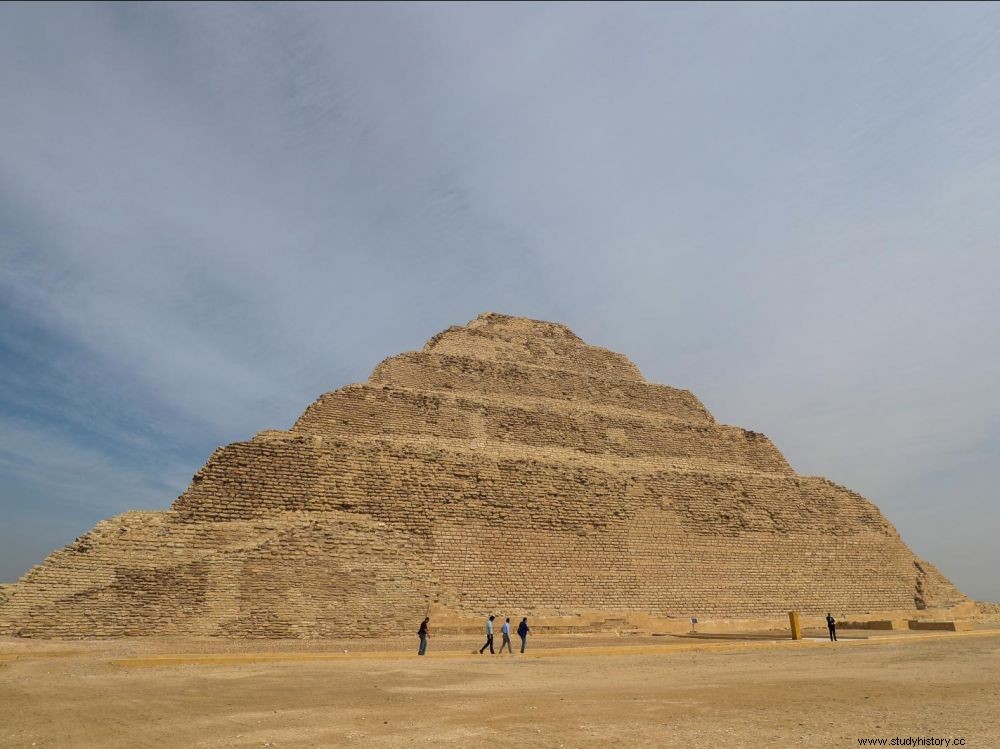After 14 years of restoration, the Step Pyramid of Pharaoh Djoser, the first pyramid in history, has been reopened to the public.

4700 years old, the step pyramid of Pharaoh Djoser after restoration.
It took 14 long years for the first pyramid ever erected in Egypt to be officially reopened to visitors on March 5, 2020. Located west of Cairo, near the archaeological site of Saqqara, it was built around 4,700 years ago. , during the reign of Djoser (2628-2609), one of the rulers of the third dynasty. The 63-meter-high building consists of six mastabas ("bench" in Arabic) superimposed above a central well 28 meters deep and seven meters on a side. Its infrastructure had been seriously affected by an earthquake that occurred on October 12, 1992. The vault of the great funerary shaft and the ceilings of several underground galleries threatened to collapse, the authorities had to take the decision to close the monument to the public to initiate rehabilitation works.
A pyramid built long before the famous pyramids of Giza
Visit inside the pyramid of Djoser.
A major rehabilitation project has therefore been programmed in collaboration with Unesco, the pyramid being classified as a World Heritage Site. An internal and external restoration of the building was undertaken, which included the consolidation of the underground tunnels, a control of the cracks and the interior ventilation, as well as the development of the internal corridors leading to the funeral shaft, where was exhibited the sarcophagus of Pharaoh Djoser. Launched in 2006, the restoration project was due to end in 2009. But it had to be interrupted in 2011, due to the political situation and the economic crisis which then agitated Egypt, before resuming at the end of 2013. During At the press conference on March 5, 2020, the Egyptian authorities claimed that this restoration project was one of the most ambitious ever implemented in the country at a cost of $6.6 million.
It is to the architect and vizier Imhotep - whose name means "he who comes in peace" - that we owe this step pyramid built long before the famous pyramids of Giza, located further north. Its construction took 19 years and its study has proved fascinating to archaeologists. In particular those of the French architect Jean-Philippe Lauer, who died in 2001 at the age of 99, who devoted his life to it. The foundations are particularly spectacular. Before erecting this monumental tomb, the ancient Egyptian builders dug an immense underground network of tunnels under the surface. A labyrinth that no other pyramid presents.
An asset for the Egyptian tourist offer
With the next opening of the Grand Egyptian Museum (GEM) scheduled for the end of 2020, and those already carried out in 2018 for the pyramids of Bent (rhomboidal) and its neighbor the "red pyramid" in Dahshur, this new restoration comes on top of the tourist offer intended to bring visitors back to Egypt. The figures for the year 2019 also appeared to be very encouraging, since Egypt's total tourist receipts would have reached 16.4 billion dollars, according to the daily Egypt Today . Egyptian authorities, however, fear a drop due to the spread of the coronavirus around the world, with tourists postponing their trip. While Egypt announced that it was affected by around forty cases (passengers infected on a cruise ship and the death of a German tourist announced on March 9, 2020 – the first official victim of the coronavirus on the African continent), the Minister of Egyptian Tourism affirmed that all measures are being taken.
*For comparison, France's tourism receipts for the year 2019 amounted to around 56 billion euros
